Coronas-Photon
EO
ROSKOSMOS
Mission complete
Quick facts
Overview
| Mission type | EO |
| Agency | ROSKOSMOS |
| Mission status | Mission complete |
| Launch date | 30 Jan 2009 |
| End of life date | 18 Apr 2010 |
| CEOS EO Handbook | See Coronas-Photon summary |
Coronas-Photon
Overview Spacecraft Launch Mission Status Sensor Complement References
Coronas-Photon (Complex Orbital Observations Near-Earth of Activity of the Sun) is a Russian (Roskosmos) solar-terrestrial science mission for the study of the solar hard electromagnetic radiation in the very wide energy range from Extreme UV (EUV) up to high-energy gamma-ray radiation. The goal of the project is to investigate the energy accumulation and its transformation into energy of accelerated particle processes during solar flares; the study of the acceleration mechanisms, propagation and interaction of fast particles in the solar atmosphere; the study of the solar activity correlation with physical-chemical processes in the Earth upper atmosphere.
Note: The spacecraft name has also the spellings of Koronas-Foton as well as of Koronas-Photon.
The main objectives of the mission are: 1) 2)
• Electromagnetic solar flare radiation and neutrons.
- Study of the temporal dynamic of hard electromagnetic radiation from full disk in a wide energy range from EUV to 2000 MeV
- Study of spatial and temporal dynamics of hot plasma regions in the solar atmosphere by observation of X-ray radiation
- Nuclear gamma-ray spectroscopy of solar activity regions; detection of solar neutrons with energies higher 20 MeV
- Measurement of linear polarization and rapid variability of hard X-ray emission during solar flares
- Monitoring of the solar EUV radiation, soft and hard X-ray emissions.
• Charge particle environment measurements.
- Monitoring of energy and angular distributions of electrons and protons
- Measurement of nuclei energy and mass distributions.
• Parallel astrophysical observations
- Study of hard X-ray and gamma-radiation from gamma-ray bursts
- Study of X-ray radiation from the bright local sources in the Ecliptic plane.
• Parallel geophysical observations
- Monitoring of Earth's upper atmosphere by occultation measurements of EUV radiation and soft X-rays originating from the quite sun.
Coronas-Photon is part of the international program LWS (Living With a Star). The Russian partners in this mission are from Poland, India, and Ukraine. The leading Russian research institute responsible for the payload of the mission is Moscow Engineering Physics Institute (MEPhI, State University, PI: Yuri D. Kotov); the leading design organization responsible of the spacecraft is NIIEM (Scientific-Research Electromechanic Institute), Istra, Moscow region.
Coronas-Photon is the third satellite in this series. Two previous missions of the project are Coronas-I (launch on March 2, 1994) and Coronas-F (launch on July 31, 2001).
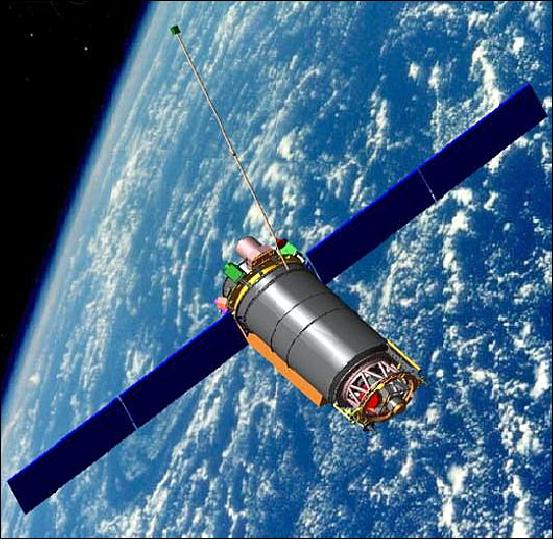
Spacecraft
The spacecraft platform is of Meteor-M satellite heritage designed and developed at VNIIEM of Moscow and NIIEM (Scientific-Research Electromechanic Institute), Istra, Moscow region. The spacecraft is three¿axis stabilized, it is sun-pointing. The S/C pointing accuracy is 0.1º, the angular drift rate is 0.0005º/s. A navigation subsystem (GPS/GLONASS receiver) provides orbit determination and timing services. Solar power of ~ 2 kW (BOL) is provided by two deployed panels which are continuously sun pointed for optimum power generation.
SM-8M magnetometer: The instrument is used to determine the spacecraft axis orientation using the Earth's magnetic filed. In addition, the magnetometer output is used in conjunction with the charged particle analyzers of the payload (Penguin-M, and STEP-F). . The magnetometer allows to measure three perpendicular projections of Earth magnetic field induction vector on orthogonally located magneto-responsive elements (ferro-sondes). It produces signals in form of direct current amplitude proportional to the projections.
Spacecraft launch mass | 1900 kg |
Payload mass | 540 kg |
Nominal design life | 5 years |
Spacecraft stabilization | 3-axis stabilized |
Accuracy of the spacecraft longitudinal axis orientation to the sun | better than 5 arcmin |
RF communications (TT&C) | S-band with a data transmission rate of 62.5 or 125 kbit/s |
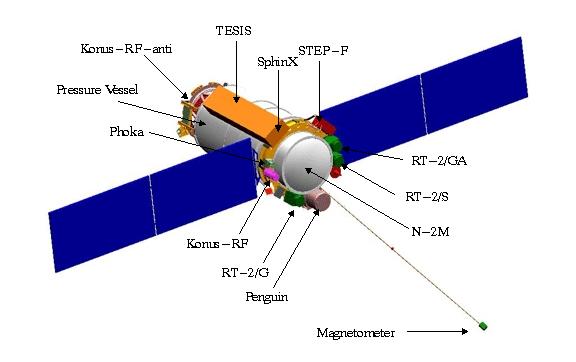
Launch
The Coronas-Photon spacecraft was launched on January 30, 2009 on a Tsyklon-3 (Cyclone-3) vehicle from the Plesetsk Cosmodrome, Russia.
Orbit: Circular orbit, altitude = 550 km, inclination = 82.5º, orbital period = 95 minutes.
RF communications: The TT&C data links are in S-band at downlink rates of 62.5 or 125 kbit/s.
The payload data are downlinked in X-band at 8.2 GHz with a transfer rate of 7.68 Mbit/s. The onboard SSRNI (Scientific Data Acquisition and Registration System), provided by IKI, acquires data from scientific payload and stores it in the onboard memory. SSRNI delivers the onboard time code, 1 second labels and operation commands. The number of supported devices is up to 24. The SSRNI has a storage capacity of 4 Gbit. The mass of the subsystem is 9 kg, the transmission power is 8 W.
Mission Status
• On April 18, 2010, Russian project officials announced that the satellite was lost "with a good deal of certainty". 3)
• In January 2010, the Russian scientific satellite Coronas-Photon has failed to go back fully online during maximum illumination orbits. Scientists are almost certain that its mission cannot be resumed. 4)
• On December 29, 2009, Coronas-Photon has started transmitting signals after staying silent for several weeks. 5)
• On December 1, 2009, Coronas-Photon experienced a power failure. All attempts to reanimate the spacecraft failed so far.
The spacecraft experienced power problems starting on Oct. 12, 2009. As a consequence, the science payload was switched off. On Dec. 1, 2009, all spacecraft communications stopped in uplink and downlink. A possible reason for this failure may be due to insufficient voltage of the power supply. The project is waiting until April 2010 when a weak non-shadow period is expected for better power conditions. However, the chances are rather small to get the spacecraft operational again. 6)
• As of March 2009, the following instruments are operating nominally: Penguin-M, Konus-RF, Electron-M-PESCA, PHOKA, STEP-F, BRM, SphinX, RT-2 (G and S detectors), TESIS (Telescopes 171A, 304A, 132A) and MgXII imaging spectroheliometer.

Legend to Figure 3: An amazingly beautiful and rare phenomenon on the sun, recorded by the TESIS telescope. For nearly three days the eastern limb of the sun was lit up as if lit by fire: here simultaneously "blazed" about ten protuberances, which were being stretched into the crown of the sun at the height of more than 100 thousands of kilometers. Word of "blazed" is not simply a beautiful epithet. In this case, it accurately portrays the phenomenon. 7)
• At the end of Feb. 2009, the instruments: Natalia-2M, SOKOL, RT-2/CZT and two TESIS channels (FET, SEC) were still in the commissioning phase. 8)
• On 20 February 2009, STEP-F entered into operation.
Sensor Complement
Scientific payload for solar radiation observation consists of three types of instruments - provided by institutions in Russia, India, Ukraine, Spain and Poland. 9) 10) 11)
Instrument | Prime observation parameters | Developing organization |
Natalya-2M | - Gamma-ray spectroscopy 0.3 – 2000 MeV | MEPhI (Moscow Engineering Physics Institute), Russia |
RT-2 | - Hard X-ray spectroscopy 10–150 keV in phoswich mode | TFIR (TATA Institute of Fundamental Research), Mumbai (Bombay), India |
Penguin-M (Hard X-ray polarimeter-spectrometer) | - Hard X-ray polarization 20 – 150 keV | Ioffe Physical-Technical Institute, St-Petersburg, Russia |
Konus-RF (X-ray and gamma-ray spectrometer) | Solar flares and gamma-ray bursts hard X-ray & gamma-ray | Ioffe Physical-Technical Institute, St-Petersburg, Russia |
X-rays | ||
BRM (Fast X-ray Monitor) | Hard X-ray monitoring 20–600 keV in 6 channels with time resolution 2–3 ms | MEPhI, Russia |
PHOKA (Multi-channel ultraviolet monitor) | - Full disk EUV radiation 1 – 130 nm in six spectral windows | MEPhI, Russia |
TESIS (Solar telescope/imaging spectrometer) | Sun full-disk image in spectral channels: | Lebedev Physical Institute (LPI), Moscow, Russia |
Cosmic rays | ||
Electron-M-PESCA | Flux and energy spectra registration: | Scobeltsyn Institute of Nuclear Physics at Moscow State University, Russia; |
STEP-F (Satellite telescope of electrons and protons) | Flux and energy spectra registration: | Kharkov National University, Ukraine |
Scientific support systems | ||
SM-8M (magnetometer) | Measurements of three components of constant magnetic field on satellite orbit in the range of ±55 µT | FGU NPP "Geologorazvedka", St-Petersburg, Russia; |
SSRNI (Scientific data acquisition and registration system) | - Scientific data reception from 24 digital array sources by parallel interface up to 125 kbit/s | IKI (Space Research Institute), Moscow, Russia |
BUS-FM (Control and communications block) | Power supply and instrument control with 200 single commands and programmed command information | IKI (Space Research Institute), Moscow, Russia |
X-band radio transmitter set 8.2 GHz | Scientific data transmission to the ground station in the frequency range of 8.2 GHz (X-band), | Russian Institute of Space Device Engineering, Moscow, Russia |
Natalya-2M (High energy radiation spectrometer)
The Natalya-2M instrument is provided by MEPhI, Moscow. The objectives of the experiment are the study of the temporal dynamics of hard electromagnetic radiation in a wide energy range from 0.3 to 2 GeV; and the registration of solar neutrons in the energy range of 20 – 300 MeV. 12)
Natalya-2M consists of two spectrometers having eight scintillation modules with CsI(Tl) crystals each and anti-coincident protection detectors from polystyrene in the registration block of “Natalya-2M” (Figure 4). The upper spectrometer is surrounded by the anticoincidence protection which consists of the 2 cm thick scintillation dome and plane detector. All scintillation modules are identical, they are CsI(Tl) crystal based blocks 4.5 cm x 8 cm x 36 cm in size. The modules form two layers (4 crystals in each); the nearby layers are rotated relative to each other by 90º.
Each block is viewed by two photomultiplier tubes from opposite sides. All spectrometer channels are stabilized by reference light source signals through optical fibers during operation. Alpha and gamma nuclear radioactive sources are used for absolute energy calibration. The output signals from the opposite preamplifiers on each module are summed. The stabilization system provides maintenance of the specified amplification of PMT/electronics channel not worse than 1.5% in wide ranges of temperature, supply voltage, magnetic field and spectrometer loading in laboratory.

Channel | Energy range (MeV) | Effective area (cm2) | Energy resolution (ΔE/E) | Time resolution |
R (X-ray) | 0.3-2 | 920 | 10% (662 keV) measured | 1 ms |
L (low gamma ray) | 2-10 | 900 | 5% (2.5 MeV) measured | 1 s |
M (middle gammy ray) | 7-200 | 800 | 6% (10MeV) calculated | 1 s |
H (high gamma ray) | 50-2000 | 750 | 32% (500 MeV) calculated | 1 s |
N (neutrons) | 20-300 | 37-120 | - | 32 s |
The separation of "gamma" and "neutron" events is based on the scintillation signal shape analysis in the upper spectrometer. The coefficient of the neutron/gamma resolution is about 103.
The Natalya-2M instrument has a mass of ~ 260 kg.
RT-2 (Roentgen Telescope-2)
The instrument was designed and developed by TFIR, India (a cooperative project of India and Russia). The participating institutes in India are:
- TFIR (Tata Institute of Fundamental Research), Mumbai
- ICSP (Indian Centre for Space Physics), Kolkota. Development of the phoswich/CZT detector payload system.
- VSSC (Vikram Sarabhai Space Centre), Thiruvanthapuram
- ISRO (Indian Space Research Organization), Bangalore
The objectives are: 13)
• the study of X-ray and gamma-ray space sources (sun, galactic and extragalactic X-ray sources, active galaxies nuclei, gamma-ray bursts, hard X-ray diffuse background)
• registration of the temporal profiles of solar and galaxy X-ray radiation in the energy range of 10 – 150 keV
• X-ray radiation spectrometry in the energy range of 0.10 – 2 MeV.
Parameter | Scintillation detector: Mode | Semiconductor solid detector | |
Phoswich | Spectrometric | ||
Energy range | 10 - 150 keV | 0.10 - 2 MeV | 10 - 80 keV |
Effective area | 150 cm2 | 150 cm2 | 100 cm2 |
Energy resolution | 16.5% (60 keV) | 12% (662 keV) | 2% (60 keV) |
Time resolution | 1 (0.1) ms | 1 (0.1) ms | 1 (0.1) ms |
The goal of RT-2 is the study of rapid variability of X-rays in solar flares; registration of the temporal profiles of solar and galaxy X-ray radiation in the energy range of 10 – 150 keV; X-ray radiation spectrometry in the energy range of 0.10 – 2 MeV. 14)
Note: Phoswich detectors were developed to detect low-intensity, low-energy gamma rays, X-rays, as well as alpha and beta particles efficiently in a higher-energy ambient background.
RT-2 includes three detector blocks: RT-2/S, RT-2/G, RT-2/GA and electronics block RT-2/E. The detector blocks are located outside the satellite hermetic module. There are two composite scintillation detectors (phoswich) 3 mm NaI(Tl)/25 mm CsI(Na) 11.7 cm in diameter in RT-2 instrument. The scheme of the scintillation detector block is shown in Figure 5.
The detectors are identical except that the collimators angles of sight are equal to 6º x 6º and 10º x 10º. The scintillators are surrounded by passive shielding and plastic anticoincidence counters (veto). The third gamma-ray detector is based on a new type of semiconductor CdZnTe (CZT). Its feature is high energy resolution in the temperature range of ±10ºC. The thickness of the crystal is 2 mm.
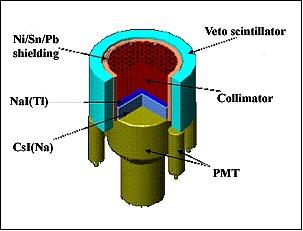
The on-board memory storage is 8 Mbit during one or two telemetry transmissions to the Earth. The total mass of RT-2 is 55 kg; it includes three detector blocks of 15 kg each and the electronics block of 10 kg. 15)

Penguin-M (Hard X-ray polarimeter)
Penguin-M is an instrument of the Ioffe Physical-Technical Institute, St. Petersburg, Russia. The objectives of Penguin-M is the study of solar flares in the X-ray and gamma-ray spectra and the measurement of the linear polarization. 16)
• Measurement of hard X-ray linear polarization parameters in solar flares in the energy range of 20 – 150 keV
• X-ray and gamma-ray spectroscopy of solar flares in the energy range of 15 keV – 5 MeV
• Monitoring of soft X-ray solar radiation in the energy range of 2 – 10 keV.
The detector block PMD (Penguin-MD) together with the electronic block PME (Penguin-ME) constitutes the scientific equipment Penguin-M. The PMD block is developed and produced by Ioffe Physical-Technical Institute, RAS; the PME block – by Moscow Engineering Physics Institute (MEPhI).
The PMD block is based on scintillation and proportional counters and is intended for registration of spectral and polarization characteristics of X-ray and gamma-ray radiation of solar flares. Besides the radiation detectors, the PMD block contains the active shielding from charged particle background, flight calibration and auto stabilization systems of detectors amplification, and also electronic schemes carrying out processing and analysis of registered impulses, intermediate accumulation and storage of the obtained information. The connection of the PMD block with the spacecraft on-board systems and with the data acquisition and registration of scientific information system (SSRNI) is carried out through the PME block.
Principle of operation and measurement of radiation characteristics:
1) Linear polarization: The degree of linear polarization and polarization plane positional angle of hard X-rays are measured by Compton scattering asymmetry in case of polarization of an incident flux. There are detectors-scatterers from p-terphenyl for Compton scattering electrons registration and there is also an assembly of spatially oriented detectors from CsI(Na) for the registration of scattered radiation in the configuration of Penguin-M. The method of coincidences is used for Compton scattering registration.
2) Hard X-ray and gamma-ray spectra: Penguin-M registers radiation incident on the upper surfaces of the scattered radiation detectors in the energy range of 20 keV – 5 MeV (128 energy channels) in the absence of coincidences with impulses from the detector-scatterer. The instrument also registers radiation incident on the detector-scatterer in the energy range of 15 – 150 keV (16 energy channels) in the absence of coincidences with impulses from scattered radiation detectors.
3) Soft X-ray spectra: Proportional counters with appropriate electronic analyzers are used for research of soft X-ray solar flares radiation. Spectrum of soft X-rays is registered in the interval of energies 2 – 10 keV (32 channels). The width of the channel is about 0.2 keV at the lower energy threshold, it increases with radiation energy up to ~ 2 keV.
The radiation is registered by two interchangeable proportional counters with beryllium entrance windows and pure xenon filling. The counters have four sections each located under each other. The upper section is intended for low radiation flux registration. The second section becomes the main one for intense radiation fluxes when it registers radiation weakened by absorption.
The total mass of the Penguin-M instrument is 43 kg, the detector block has a mass of 35 kg.

Konus-RF (X-ray and gamma-ray spectrometer)
Konus-RF is an instrument of the Ioffe Physical-Technical Institute, St. Petersburg, Russia. The primary goal of Konus-RF is the study of X-ray and gamma-ray solar radiation and the observation of cosmic GRBs (Gamma-ray Bursts). The specific objectives are:
- Monitoring of hard X-ray solar radiation, cosmic gamma-ray bursts and search for unusual X-ray and gamma-ray transient events during continuous all sky monitoring
- Research of temporal history and spectral evolution of solar X-ray flares with high time resolution up to 2 ms
- Search and study of solar flares gamma-radiation, including emission in nuclei lines
- Study of gamma-ray bursts temporal structure, energy spectra and mechanisms of fast spectral evolution
- Detailed research of the radiation environment on spacecraft orbits and its variations for detection of other cosmic transient and permanent discrete sources during Earth occultation.
The Konus-RF instrument uses the scintillation method of radiation registration in combination with microprocessor processing of the spectral and temporal information from the detector. The measurements are conducted in a wide energy range from 10 keV up to 12 MeV. The time resolution automatically adapts to a current level of energy emission during measurements depending on the observation task and covered energy range. It may vary from 2 ms up to several minutes which provides sufficient statistical accuracy of the information accumulated during these time intervals.
The Konus-RF instrument consists of two detector blocks and a separate electronic block which includes a power supply and the interface with spacecraft service systems.
The field of view axis of the first detector Konus-RF-D1 is directed toward the sun. The detector field of view is 2 steradian. The second detector Konus-RF-D2 is focused in an anti-sun direction. Crystals of NaI(Tl) 127 mm in diameter and 76.2 mm in height are used in both detectors. The scintillator is placed in the thin-walled aluminum container with an entrance front window from beryllium. The crystal is viewed by the photo multiplier put behind thick lead glass of high transparency that allows to lower the intensity of the radiation background from the spacecraft. The energy resolution of the detector at 662 keV is 8%.
The Konus-RF instrument has a total mass of ~ 32 kg and a power consumption of about 10 W.
BRM (Fast X-ray monitor)
BRM is an instrument of MEPhI, Moscow. The goal is the study of hard X-ray radiation in solar flares. Specific objectives are: 17)
- Fast monitoring of hard X-ray solar radiation in the energy range of 20 – 600 keV with 2 – 3 ms time resolution
- Registration of solar flare X-ray radiation temporal profile in six energy sub-bands.
The BRM instrument uses a fast scintillation detector. The scintillation crystal material is YAlO3(Ce) with the following parameters: de-excitation time is 28 ns; density is 5.35 g/cm3; maximum wavelength in the emitted spectrum is 347 nm. The crystal has a cylindrical shape with dimensions of 13 mm in height and 68 mm in diameter. BRM registers radiation in the energy range of 20 – 600 keV, divided into six intervals.
Channel number | Energy channels (keV) | Effective area (cm2) | Time resolution, (ms) |
1 | 20-30 | 20 |
up to 2-3 |
2 | 30-40 | 20 | |
3 | 40-50 | 20 | |
4 | 50-70 | 20 | |
5 | 70-130 | 20 | |
6 | 130-600 | 15 | |
7 | 20-600 | 15 | |
8 | > 600 | 20 |
The BRM instrument consists of two blocks: the detector block BRM-D (Figure 8) outside the hermetic module and the electronics block BRM-EM inside the spacecraft. The BRM instrument has a total mass of 19.5 kg, the mass of the BRM-D detector block is 5.5 kg.
Principle of of operation: The collimator with a field of view of 6º is installed in front of the crystal to decrease the background. The measurement channel is stabilized using precise impulses from the light source (light-emitting diode) placed in the collimator in front of the crystal. The system stabilization reaction time is 1 s. This system controls the PMT (Photomultiplier Tube) detector power supply. This helps one to avoid the influence of output characteristics at high count rate. Signals from PMT separated according to their amplitude into six channels are transmitted to the electronic block BRM-EM for further processing. Two channels for the gamma-rays are provided in the BRM-D block as well.

PHOKA (Multi-channel ultraviolet monitor)
Phoka is an instrument of MEPhI, Moscow. The goal of the Phoka instrument is to monitor the vacuum UV solar radiation and of the Earth's upper atmosphere. Specific objectives are: 18)
- Monitoring of ultraviolet solar radiation in the range of wavelengths of 1.0 – 130.0 nm
- Determination of correlation between radiation in XUV/EUV band and other energy ranges
- Occultation measurements of ultraviolet solar radiation absorption in the Earth atmosphere at the altitudes of 150 – 500 km.
The Phoka instrument is designed for the measurements of soft X-ray and ultraviolet radiation total intensity from the solar disk with a time resolution of 0.1 s in seven spectral bands. Six of them are in the XUV/EUV bands and one in optic band. Phoka is oriented on the sun.
When the solar disk is observed through Earth's atmosphere, during occultation, it is possible to obtain temperature and density distributions and to specify theoretical and empirical models of thermosphere and ionosphere.
Band number | Filter type | Filter thickness (nm) | Wavelength band (nm) | Comment |
Main bands | ||||
1 | No filter |
| < 1100 | Optical band |
2 | Ti/Pd | 200/100 | < 11 |
|
3 | Cr/Al | 100/200 | 27-37 |
|
4 | 2 external filters Acton 122-XN-0.5D |
| 116-125 | Lyman-α band |
Reserved bands (occasional use) | ||||
5 | Ti/Pd | 200/100 | < 11 |
|
6 | Cr/Al | 100/200 | 27-37 |
|
7 | 2 external filters Acton 122-XN-0.5D |
| 116-125 | Lyman-α band |
The Phoka instrument consists of the detector block Phoka-D (Figure) situated on the front frame of the satellite oriented to the sun and the electronics block Phoka-E, mounted in the hermetic module of the spacecraft. Each registration channel includes a silicon photodiode AXUV-100 in assembly with a collimator and an appropriate spectral filter, a preamplifier and a voltage-to-frequency converter. The accuracy of absolute intensity measurement is about a few percent of the total flux.
The Phoka-D instrument has a mass of 3 kg.
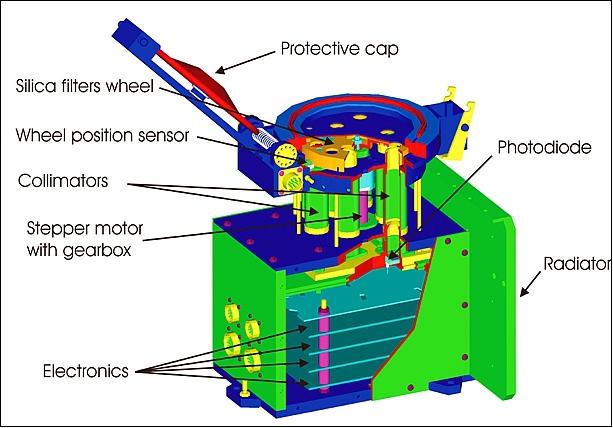
TESIS (Telescope-spectrometer for imaging solar spectroscopy in X-rays)
Instrument of LPI (Lebedev Physical Institute), Moscow. TESIS is designed for registration of solar images in narrow spectral bands and monochromatic emission lines of HeII, SiXI, FeXXI – FeXXIII, MgXII ions in high temperature plasma of the transition region and corona. 19) 20) 21)
TESIS is a project of Lebedev Physical Institute of the Russian Academy of Sciences with contribution from Space Research Center of the Polish Academy of Sciences (the spectrometer SphinX).
TESIS consists of detector block TESIS-BD, electronic block TESIS-BE and optical sensor TESIS-OD. The TESIS-BD block includes four independent telescope channels for solar image registration:
• Telescope-coronagraph 132 Å – in lines FeXXI – FeXXIII (132 – 136 Å). The device is intended for imaging hot plasma (T ~ 10 MK) of the solar corona.
• telescope-coronagraph 304 Å – in lines HeII, SiXI (295 – 315 Å)
• Bragg-crystal telescope-spectrometer Mg1 and Mg2 – in lines MgXII (8.418 – 8.423 Å) in orthogonal plane of dispersion
• the EUV imaging spectrometer SphinX
• the wide-field Ritchey-Chretien coronagraph.
Principle of operation: Images of the sun are formed on a detector sensitive area by special mirrors (Figure 10). A multi-element filter system is used for the blocking of the optical solar radiation. This system includes free super-thin films on supporting grids and polymeric membranes. CCD detectors with electrical cooling are used in all channels. The received data are processed by the onboard computer, archived and transmitted to SSRNI.
The mass of TESIS is 74 kg; the size of the detector block is: 2200 mm x 500 mm x 300 mm, electronic block: 300 mm x 250 mm x 236 mm, optical sensor block: 450 mm x 200 x 150 mm.
Parameter | Channels | |||||
MgXII | FeXX | HeII | HeII | Spectroheliograph | SphinX | |
Spectral range | 8.41-8.42 Å | 131-132 Å | 295-315 Å | 295-315 Å | 285-335 Å | 1-12 Å |
FOV | 45' | Disk: 40', Corona: 2-5 Rsun | 2.5º |
| - | |
Angular resolution | 3'' | 1.7'' | 20'' | - | - | |
Spectral resolution | 0.0002 Å/pixel | 70 Å | 20 Å | 20 Å | - | ~ 0.05 Å |
Exposure time | 0.01-600 | 0.01-0.001 | ||||
SphinX is an X-ray spectrophotometer as part of the TESIS instrument package provided by the SRC (Space Research Center) of Poland. The objectives of SphinX are to measure the total solar X-ray flux though three different apertures with nearly identical PIN photodiode detectors. The instrument has an overall dynamic range of 7 orders of magnitude - from a small fraction of GOES class A1 to GOES class X30; the energy range is from 0.8 keV to 15 keV. SphinX has a 5% absolute photometric accuracy, so unlike GOES SphinX, it will be able to observe X-ray emissions from the quiet sun, as well as from all forms of solar activity. 22) 23)
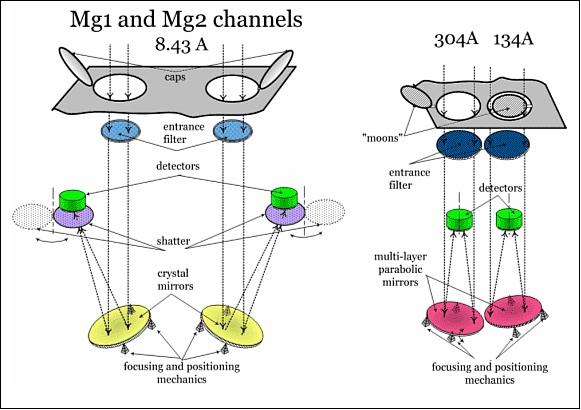
Electron-M-PESCA (Charged particle analyzer)
Instrument of Scobeltsyn Institute of Nuclear Physics at Moscow State University. The goal of the instrument is to study energetic solar particles and anomalous components of galactic cosmic rays. Specific objectives are: 24)
- Study of energetic spectra, charge and isotope composition of nuclei accelerated during solar flares
- Registration of solar electron fluxes and spectra of in the energy range of 0.2 – 2 MeV
- Registration of protons and nuclei fluxes and energy spectra on the satellite orbit.
The charge resolution of nuclei isotope composition is 0.5. The Electron-M-PESCA instrument can register fluxes up to 5 x 107 particles/cm2 s sr.
The instrument consists of the detector block Electron-MD-PESCA and the electronic block Electron-ME-PESCA. The main element of the detector block is a telescope. It is the system of four ion-implanted silicon detectors placed in a cylindrical passive aluminum protection. The system geometric factor is 2 – 3 cm2 sr. The FOV is 50º.
Registered characteristics | Energy ranges |
Spectra and fluxes of protons | 1 – 20 MeV |
Spectra and fluxes of electrons | 0.2 – 2.0 MeV |
Fluxes of nuclei with charge number Z < 26 | 2 – 50 MeV/nucleon |
Principle of operation: The specific ionization energy of particles during their movement through detectors system (Figure) is used for particle identification and determination of their energy. The pulse amplitude from a charged particle (ΔE) is measured in a counter and particles whose energy release in the n-p detector exceeds the predefined threshold are selected for further analysis. Signals from the semiconductor detector pass through multipliers and forming devices to integral discriminators. Each integral discriminator is tuned to trigger when a particle with the energy in a definite energy range passes through the detector. The system of D1 – D2 detectors is used to measure spectra and fluxes of protons. To measure fluxes of electrons the system of D1 – D4 detectors is used. And the system of D1 – D3 detectors is used to measure spectra and fluxes of alpha-particles.
Detectors | D1 | D2 | D3 | D4 |
Effective area (cm2) | 9 | 6 | 9 | 12 |
Thickness (µm) | 158 | 509 | 705 | 324 |
The sizes of the instrument blocks are: 200 mm x 186 mm x 140 mm for Electron-MD-PESCA; 250 mm x 150 mm x 284 mm for Electron-ME-PESCA. The mass of Electron-MD-PESCA block is 1.8 kg, while the mass of the Electron-ME-PESCA block is 7 kg.
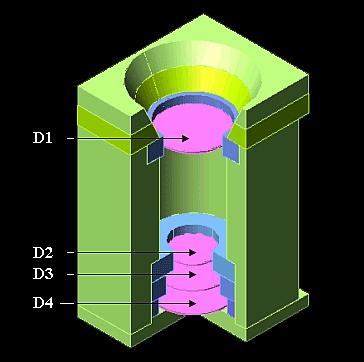
STEP-F (Satellite telescope of electrons and protons)
The instrument is provided by Karazin Kharkov National University, Ukraine. The goal of STEP-F observations is the study of Earth radiation belt dynamics during solar and magnetospheric activity. Specific objectives are: 25) 26) 27)
- Determination of the altitudes where the electric and magnetic components of Earth's magnetic field fluctuations primarily impact the radiation belts particles process of radial diffusion
- Determination of the power-low spectrum degree in the pinch-angle distributions of precipitated electrons from values Dst, Kp and AU-indices, which characterize the magnetospheric storm magnitude on different latitudes
- Search of correlations between bursts in the radio band observed on middle latitudes on the Earth surface level and solar, magnetospheric and ionospheric activity
- Research of micro bursts of high energy electrons below the outer radiation belt
- Study of the connection of captured and precipitated particle fluxes of magnetospheric origin with solar proton events and cosmic rays
- Test of the hypotheses about a generic connection of precipitated high energy electrons fluxes from Earth's radiation belts with mechanism of high frequency radio bursts generation.
The instrument consists of detector block STEP-F-D (Figure 12), installed outside the hermetic module, and the digital information processing block STEP-F-E. The detector block includes two identical silicon position-sensitive detectors and two scintillation detectors. Each silicon detector has the size of 45 mm x 45 mm with a thickness of 350 µm. The scintillation detectors are based on CsI(Tl) crystals and viewed by large area photodiodes. The average telescope field of view is 97º x 97º. The size of each of 36 matrix square element of semiconductor detector is 7.3 mm x 7.3 mm, which allows to receive the average angular resolution in telescope total field of view of about 8º. The effective area of each semiconductor detector is 20 cm2, the scintillation detectors are of size: 36 and 49 cm2. The geometric factor of the STEP-F instrument is 20 cm2 sr.
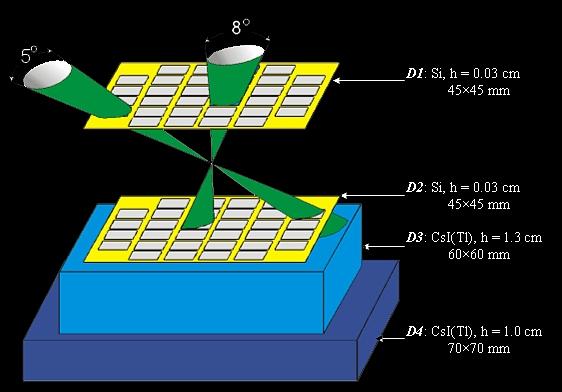
The STEP-F instrument is able to register fluxes of:
- Electrons in the energy range of 0.4 – 14.3 MeV
- Protons in the energy range of 9.8 – 61.0 MeV
- Alpha-particles in the energy range of 37.0 – 246.0 MeV.
The mass of the STEP-F instrument is about 13 kg.
References
1) Alexander Alferov, “Perspectives of the Russian Program of Fundamental Space Research, 2006-2015,” URL: http://www.unoosa.org/pdf/pres/stsc2006/tech-01.pdf
2) L. M. Zelenyi, S. I. Klimov, V. D. Kuznetsov, “Russian Federation experiments in IHY frame,” The Scientific & Technical Subcommittee of the COPUOS, 43rd session, Vienna 20 February –3 March 2006, URL: http://www.oosa.unvienna.org/pdf/pres/stsc2006/tech-23.pdf
3) “Official press release of the Laboratory of X-Ray Astronomy of the Sun of the Russian Academy of Sciences (Lebedev Physical Institute, Moscow),” April 18, 2010, URL (in Russian): http://www.tesis.lebedev.ru/info/tesis_20100418.php
4) “Sun observer likely dead,” Astronomy News, January 18, 2010, URL: http://www.rt.com/news/sci-tech/sun-observer-likely-dead/
5) “Solar observer still kicking,” Astronomy News, Dec. 29, 2009, URL: http://www.rt.com/news/sci-tech/solar-observer-still-kicking/
6) Information provided by Yury Kotov (PI of the “Coronas-Photon” mission) of MEPHI, Moscow
7) http://www.activeboard.com/forum.spark?aBID=58381&p=3&topicID=23159525
8) Information provided by Yury D. Kotov of MEPHI, Moscow, Russia
9) Yuri Kotov, “Observational capabilities of solar satellite Coronas-Photon,” 36th COSPAR Scientific Assembly, Beijing, China, July 16-23, 2006
10) Yuri D. Kotov, V. N. Yurov, R. S. Salihov, “,” Proceedings of the 27th ICRC (International Cosmic Ray Conference), Hamburg, Germany, Aug. 7-15, 2001, URL: http://icrc2001.uni-wuppertal.de/ICRC2001/papers/ici6374_p.pdf
11) Yu.D. Kotov, Yu.I. Alikin, R.L. Aptekar, A.I. Arkhangelsky, K.V. Anufreichik, M. V. Bessonov, S. I. Boldyrev, S.A. Bogachev , M.V. Buntov, A. S. Buslov, K. F. Vlasik, A. K. Goncharov, Yu.I. Denisov, V. A. Dergachev, A. V. Dudnik, M. P. Gassieva, A.S. Glyanenko, V. V. Kadilin, P. A. Kalmykov, I. V. Kozlov, A. V. Kochemasov, E. M. Kruglov, S. V. Kuzin, V. D. Kuznetsov, N. I. Lebedev, E. E. Lupar, G. A. Matveev, E. P. Mazets, A. Nandi, N. N. Novikova, A. A. Pertsov, A. R. Rao, I. V. Rubsov, A. D. Ryabova, M. I. Savchenko, R. S. Salikhov , B. Sylvester, J. Sylvester, Yu. A. Trofimov, V. G. Tyshkevich, M. K. Hingar, V. V. Khmylko, S. K. Chakrabarti, S. Sankarattil, Y. Chichikaljuk, I. V. Chulkov, V. N. Yurov, “Solar mission Coronas-Photon: in-orbit status and first results,” Proceedings of the 31st ICRC, Lodz, Poland, 2009, URL: http://icrc2009.uni.lodz.pl/proc/pdf/icrc1523.pdf
12) Yu. D. Kotov, V. N. Yurov, E. E. Lupar, K. F. Vlasik, A. I. Arkhangelsky, A. S. Glyanenko, I. V. Rubtsov, V. V. Kadilin, V. G. Tyshkevich, “The NATALYA-2M spectrometer of high-energy radiations for the CORONAS-PHOTON space project,” Solar System Research, Volume 45, No. 2, 2011, pp.97-122, DOI: 10.1134/S0038094611020080
13) Anuj Nandin, A. R. Rao, Sandip K. Chakrabarti, J. P. Malkar, S. Sreekumar, Dipak Debnath, M. K. Hingar, Tilak Kotoch, Yuri Kotovk, Andrey Arkhangelskiy, “Indian Payloads (RT-2 Experiment) Onboard CORONAS-PHOTON Mission,” Proceedings of the First International ICST Conference, Athens, Greece, Dec. 2009, URL: http://repository.ias.ac.in/85575/1/36-pub.pdf
14) D. Debnath, A. Nandi, S. K. Chakrabarti, A. R. Rao, P. K. Manoharan, “Solar science using RT-2 payloads aboard Coronas-photon satellite,” Proceedings of the 25th meeting of ASI, 2007, p. 82, publication in BASI (Bulletin of the Astronautical Society of India), 2008
15) A. R. Rao, J. P. Malkar, M. K. Hingar, V. K. Agrawal, Sandip K. Chakrabarti, Anuj Nandi, D. Debnath, T. B. Kotoch, R. Sarkar, T. R. Chidambaram, P. Vinod, S. Sreekumar, Y. D. Kotov, A. S. Buslov, V. N. Yurov, V. G. TyshkeVich, A. I. Arkhangelsky, R. A. Zyatkov, “Onboard performance of the RT-2 detectors,” Solar System Research, Volume 45, No 2, 2011, pp. 123-134, DOI: 10.1134/S0038094611020158
16) Yuri Kotov, Valentin Dergachev, Vitaly Yurov, Alexander Glyanenko, Andrey Arkhangelskiy, Evgeny Kruglov, Vadim Lazutkov, Gennady Matveev, Alexsei Pyatigorsky, Mikhail Savchenko, Vladislav Khmylko, Dmitri Skorodumov, Yuri Chichikaljuk, Igor Shishov, Anton Buslov, “First Two Months Operation of Hard X-ray Polarimeter PENGUIN-M On-board Satellite CORONAS-PHOTON,” Proceedings of the 31st ICRC (International Cosmic Ray Conference), Lodz, Poland, 2009, URL: http://icrc2009.uni.lodz.pl/proc/pdf/icrc1534.pdf
17) Yu. A.Trofimov, V. N. Yurov, Yu. D. Kotov, E. A. Zhuchkova, “The experiment with the fast X-ray monitor (BRM) instrument onboard the CORONAS-PHOTON satellite,” Solar System Research, Vol. 45, No 2, 2011, pp. 146-152, DOI: 10.1134/S003809461102016X
18) Yury Kotov, Alexey Kochemasov, Vitaly Yurov, Raj Korde, “Monitor PHOKA for solar XUV/EUV irradiation measurement onboard Coronas-Photon mission,” 37th COSPAR Scientific Assembly, July 13-20, 2008, Montréal, Canada., p.1595, paper: D22-0044-08
19) Yury Kotov, Alexey Kochemasov, Sergey Kuzin, Vladimir Kuznetsov, Janusz Sylwester, Vitaly Yurov, “Set of instruments for solar EUV and soft X-ray monitoring onboard satellite Coronas-Photon,” 37th COSPAR Scientific Assembly. July 13-20, 2008, Montréal, Canada., p.1596
20) S. V. Kuzin, I. A. Zhitnik, S. A. Bogachev, S. V. Shestov, O. I. Bugaenko, N. K. Suhodrev , A. A. Pertsov, A. V. Mitrofanov, A. P. Ignat'ev, V. A. Slemzin, “TESIS experiment on XUV imaging spectroscopy of the Sun onboard the CORONAS-PHOTON satellite,” Proceedings of the International Astronomical Union (IAU), 2006, Volume 2, pp.:449-451, Cambridge University Press, doi:10.1017/S1743921306002481
21) S. V. Kuzin, S. A. Bogachev, I. A. Zhitnik, S. V. Shestov, V. A. Slemzin, A. V. Mitrofanov, N. K. Sukhodrev, A. A. Pertsov, A. V. Ignat’ev, O. I. Bugaenko, Yu. S. Ivanov, A. A. Reva, M. S. Zykov, A. S. Ul’yanov, S. N. Oparin, A. L. Goncharov, T. A. Shergina, A. M. Urnov, V. A. Solov’ev, S. G. Popova, “The TESIS Solar imaging spectroscopy experiment on board the CORONAS-Photon satellite,” Physics and Astronomy, Bulletin of the Russian Academy of Sciences: Physics, Vol. 74, No 1, January 2010, DOI: 10.3103/S1062873810010090, pp.33-37,
22) J. Sylwester, S. Kuzin, Yu. D. Kotov, F. Farnik, F. Reale, “SphinX: A Fast Solar Photometer in X-rays,” Journal of Astrophysics and Astronomy, Vol. 29, pp. 339–343, URL: http://www.ias.ac.in/jaa/marjun2008/JAA42.pdf
23) Janusz Sylwester, Mirek Kowalinski , Jarek Baka¿a, Szymon Gburek, Marek Siarkowski, Barbara Sylwester, Zbigniew Kordylewski, Piotr Podgórski, Witold Trzebi¿ski, Stefan P¿ocieniak, Anna K¿pa, “SphinX soft X-ray spectrophotometer,” Nov. 2008, URL: http://www.cbk.pan.wroc.pl/body/publikacje/2008/JC_JS_Sphinx_2008_11_06.ppt
24) Yu. I. Denisov, V. V. Kalegaev, I. N. Myagkova, M. I. Panasyuk, “Experiment on the measurement of charged particle flows with ELECTRON-M-PESCA onboard the CORONAS-PHOTON solar research satellite,” Solar System Research, Volume 45, No 3, 2011, pp. 206-211, DOI: 10.1134/S0038094611020031
25) “STEP-F Satellite Telescope for measuring electrons and protons is in space and it’s operational,” URL: [web source no longer available]
26) A. V. Dudnik, V. K. Persikov, I. I. Zalyubovsky, T. G. Timakova, E. V. Kurbatov, Yu. D. Kotov, V. N. Yurov, “High-sensitivity STEP-F spectrometer-telescope for high-energy particles of the CORONAS-PHOTON satellite experiment,”Solar System Research, Volume 45, No 3, 2011, pp. 212-220, DOI: 10.1134/S0038094611020043
27) P. Podgorski, O. V. Dudnik, S. Gburek, M. Kowalinski, J. Sylwester, M. Siarkowski, S. Plocieniak, “Particle signatures in SphinX and STEP-F measurements possible new directions for common data analysis,” Poster, 2009, URL: http://www.cbk.pan.wroc.pl/body/presentations/SOTERIA3_PP_Poster4.pdf
The information compiled and edited in this article was provided by Herbert J. Kramer from his documentation of: ”Observation of the Earth and Its Environment: Survey of Missions and Sensors” (Springer Verlag) as well as many other sources after the publication of the 4th edition in 2002. - Comments and corrections to this article are always welcome for further updates to eoportal@symbios.space.